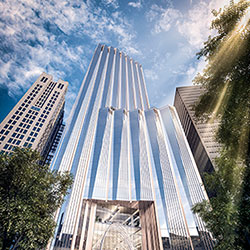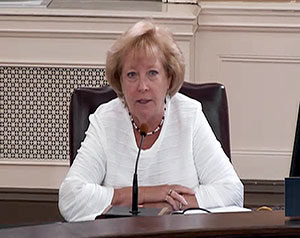
The proposed structure in Boston is believed by many to become a possible cause of additional air traffic over Somerville, due to its proximity to Logan International airport. — Photo courtesy of Handel Architects
By Jim Clark
A resolution was put forward at the latest regular meeting of the Board of Alderman last week that the Administration update the Board regarding the request that the FAA reject any design of skyscraper at Winthrop Square in downtown Boston which would be 775 feet tall, as more traffic would likely be allocated to Runway 33L at Logan International airport if such a design is approved.
The primary concern is that such a tall building situated so close to the airport would likely lead to blocking of a particular takeoff and landing corridor and increase air traffic over Somerville. An issue that residents and civic leaders have been complaining about for some time.
The Massachusetts Port Authority (Massport) has already been grappling with the issue since earlier this year when it openly questioned the wisdom of allowing the development to proceed as proposed because of the restrictions imposed on Logan’s airspace.
The developer of the proposed tower, Millenium Partners, purchased the Winthrop Square property from the City of Boston last year, submitting several iterations in height ranging from 725 to 775 feet. Massport has said that it prefers the lower height, but at this time the higher range is the current working proposal.

City officials are fired up over the prospects of even more air noise pollution due caused by the presence of the proposed development in Boston.
The Somerville Board of Alderman’s resolution was sponsored and approved by the full Board.
As a Board member who has placed particular focus on the air traffic noise pollution issue, Alderman At-Large Mary Jo Rossetti was especially emphatic in her remarks on the matter. “We’ve been receiving multiple communications again over the summer as it related to the annoyance of the air traffic volume, and that’s an ongoing issue,” Rossetti told the Board. “What we have unfortunately learned is that in the Boston Common area there is a potential for this 775 foot building to be constructed.”
Rossetti indicated that she immediately spoke with the City of Somerville administration when it came to her attention and they were taken aback and communicated with the state delegation.
“If this building is constructed the noise we’re having now will increase dramatically, because the flights will now be positioned to go more in our direction, more than we’re already dealing with,” Rossetti said.
The alderman reported that on the very day of the Board meeting she received three “very angry” emails from neighbors who have had it.
“It’s very concerning that Boston pretty much has the authority, as I understand it, to go ahead and build it because legislation was already adopted,” Rossetti said. “And it kind of slipped through, quite honestly, from what I understand.”
Board President William A. White Jr. shared his understanding of the matter saying, “There was legislation that basically prohibited certain shadowing on the Boston Common and the Baker administration, because this was going to be such a good project for the City of Boston, basically shepherded that through so the shadowing restriction was eliminated.”
White went on to point out that there is still an issue about the building’s height and its intrusion into the airspace and whether the FAA can assert veto authority over it or not. “That is the question nobody has given a firm opinion on,” said White. “There are some people who don’t believe the FAA can, even though they do have control over the airspace, and there are others who say that the FAA does.”
In a pointedly tongue-in-cheek analogy, White said that in his view, if the FAA does not, in fact, have jurisdiction then what the City of Somerville should do is “get together with the City of Chelsea, find one of our developers here and have them build a thousand foot building in Chelsea, right in front of the runway, so that we won’t have any planes ever going over the City of Somerville.”
“So if that’s a possibility, it seems rather strange that communities will be able to block runways by building buildings, said White. “So I would think perhaps the FAA has jurisdiction over it.”
A conference call between city and state officials, along with legal experts was planned as a follow up, and the Board’s resolution was duly approved.















How high is too high? Do such skyscrapers need to be built?
Maybe events such as 9/11 would never have been possible if buildings had a limit to how high they could be. We need to think about safety on the ground as well as in the air when designing buildings such as these.
If all you can do is build upward, perhaps that’s a sign that you’ve already built enough.
The FAA and MassPort do not have jurisdiction over local zoning or the height of buildings. Municipalities have the legal right to zone and determine local building heights. State law may override municipalities but in this case City of Boston preliminary approvals and recent changes in state law have so far been going the wrong way. Any height over 710 for the Winthrop Square Millennium Tower will change the risk geometry of departures from Runway 27 and likely result in FAA, MassPort and airline decisions not to use R27, with proportional shifts to Runway 33 Left. The current proposed height will likely eliminate use of R27. – Wig